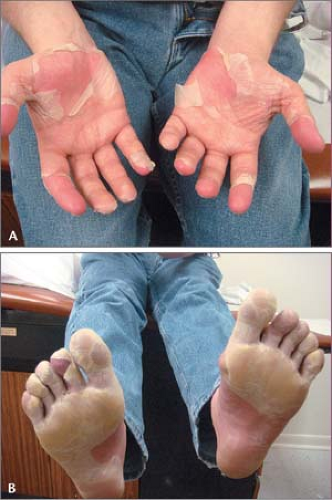Bacterial Exanthems
Kenneth Howe
Herbert P. Goodheart
 Scarlet fever
Scarlet fever
 Toxin-mediated streptococcal and staphylococcal disease
Toxin-mediated streptococcal and staphylococcal disease
 Kawasaki’s syndrome
Kawasaki’s syndrome
Overview
The term exanthem refers to a widespread, symmetric, erythematous rash that begins with macules and papules that remain discrete or become confluent. The eruption may or may not be pruritic and is usually accompanied by systemic symptoms such as fever, malaise, and headache. In pediatric populations exanthems are usually caused by infectious agents such as viruses and bacteria; infrequently, they may be due to a drug reaction.
Bacterial exanthems represent either a reaction to a bacterial toxin, direct injury to the skin by the organism itself, or an immune response. Many common childhood bacterial exanthems have characteristic features, distributions, durations, and systemic symptoms. As with viral exanthems (see Chapter 8, “Viral Exanthems”), when there are no typical lesions or distinctive prodromal signs or symptoms, a specific diagnosis is often difficult, if not impossible, to make. However, a definitive diagnosis may be critical, particularly if a pregnant woman or an immunocompromised patient has been exposed to an infected individual. Furthermore, some of these conditions can become life threatening if not treated promptly with appropriate medications, e.g., Kawasaki’s disease.
Scarlet Fever
Basics
Scarlet fever (SF) is a streptococcal infection of the pharynx associated with widespread mucocutaneous changes that are caused by an erythrogenic exotoxin-producing strain of group A beta-hemolytic streptococci. Less commonly, SF may follow streptococcal wound infections or burns, as well as upper respiratory tract infections.
In the past, SF was a major public health threat. However, its morbidity, mortality, and incidence have declined markedly, both because of the development of antibiotics and because of a reduction in the virulence of the streptococci causing the condition.
The cutaneous manifestations of SF represent a delayed hypersensitivity response to streptococcal products. Thus, prior exposure to streptococci is a necessary precondition for SF.
Etiology
Usually, group A beta-hemolytic Streptococcus pyogenes is the pathogenic organism. Uncommonly, exotoxin-producing Staphylococcus aureus may be responsible.
Description of Lesions
A finely papular erythematous rash appears on the trunk and extremities. This rash may be referred to as “sandpapery” or “scarlatiniform.”
The skin around the mouth may show a characteristic pallor (circumoral pallor). Linear streaks of petechiae called Pastia’s lines may develop in flexural areas such as the antecubital fossae, the axillae, and the inguinal region.
Mucosal findings include erythema and edema of the pharyngotonsillar area, punctate erythematous macules and petechiae on the palate, and “strawberry tongue.” The last is a characteristic finding and is caused by prominence of the papillae on the surface of the tongue.
During the convalescent phase of the illness, the skin of the palms and soles frequently desquamates. This desquamation may be sheetlike, and the original infection may have passed unnoticed. In such instances, the patient may seek medical attention solely for the desquamation (Figs. 9.1 A and B).
Distribution of Lesions
The scarlatiniform eruption is widespread and symmetric, primarily affecting the trunk and extremities.
Clinical Manifestations
SF typically begins with the abrupt onset of fever, sore throat, headache, and chills.
Complications are uncommon but may include pneumonia, pericarditis, meningitis, hepatitis, glomerulonephritis, and rheumatic fever. Erythema nodosum and acute guttate psoriasis may also follow or accompany an infection with group
A beta-hemolytic streptococci (see Chapter 25, “Cutaneous Manifestations of Systemic Disease,” and Chapter 3, “Psoriasis”).
SF can recur, with reported recurrence rates as high as 18%.
Diagnosis
The diagnosis of SF is often made on clinical grounds.
The isolation of group A streptococci from the pharynx, or the presence of serologic tests such as an elevation of antistreptolysin-O titers, can help confirm the diagnosis.
Streptococcal or staphylococcal toxic shock syndromes are distinguished by hypotension and multiorgan system involvement.
Kawasaki’s syndrome (see discussion later in this chapter) is characterized by prominent lymph-adenopathy.
Febrile drug reactions cause a blotchy, erythematous rash. Pastia’s lines and strawberry tongue are not present.
Viral exanthem is a possible diagnosis.
Flaccid bullae are the predominant feature of staphylococcal scalded-skin syndrome, which occurs in newborns and in infants younger than 2 years (see Chapter 27, “Special Considerations in Pediatric and Elderly Skin.”)
First-line treatment is with penicillin. Alternatives include erythromycin, cephalosporins, ofloxacin, rifampin, and newer macrolide antibiotics.
Emollients can be used to soothe the scarlatiniform eruption.
Toxin-Mediated Streptococcal and Staphylococcal Disease
Stay updated, free articles. Join our Telegram channel

Full access? Get Clinical Tree





